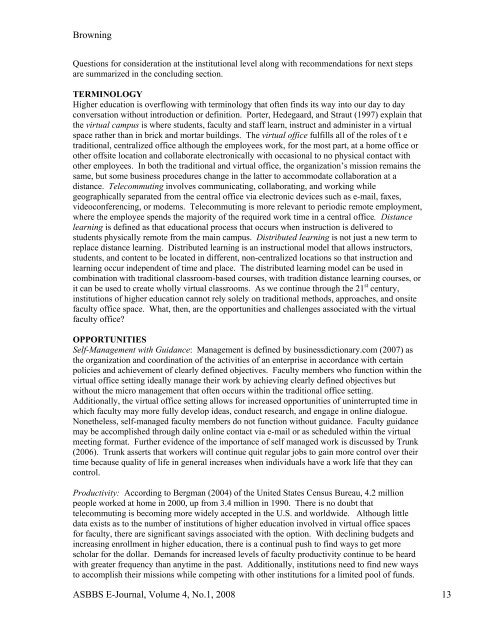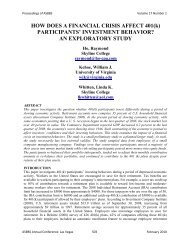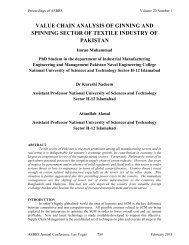stock repurchase announcements: a test of market ... - Asbbs.org
stock repurchase announcements: a test of market ... - Asbbs.org
stock repurchase announcements: a test of market ... - Asbbs.org
Create successful ePaper yourself
Turn your PDF publications into a flip-book with our unique Google optimized e-Paper software.
Browning<br />
Questions for consideration at the institutional level along with recommendations for next steps<br />
are summarized in the concluding section.<br />
TERMINOLOGY<br />
Higher education is overflowing with terminology that <strong>of</strong>ten finds its way into our day to day<br />
conversation without introduction or definition. Porter, Hedegaard, and Straut (1997) explain that<br />
the virtual campus is where students, faculty and staff learn, instruct and administer in a virtual<br />
space rather than in brick and mortar buildings. The virtual <strong>of</strong>fice fulfills all <strong>of</strong> the roles <strong>of</strong> t e<br />
traditional, centralized <strong>of</strong>fice although the employees work, for the most part, at a home <strong>of</strong>fice or<br />
other <strong>of</strong>fsite location and collaborate electronically with occasional to no physical contact with<br />
other employees. In both the traditional and virtual <strong>of</strong>fice, the <strong>org</strong>anization’s mission remains the<br />
same, but some business procedures change in the latter to accommodate collaboration at a<br />
distance. Telecommuting involves communicating, collaborating, and working while<br />
geographically separated from the central <strong>of</strong>fice via electronic devices such as e-mail, faxes,<br />
videoconferencing, or modems. Telecommuting is more relevant to periodic remote employment,<br />
where the employee spends the majority <strong>of</strong> the required work time in a central <strong>of</strong>fice. Distance<br />
learning is defined as that educational process that occurs when instruction is delivered to<br />
students physically remote from the main campus. Distributed learning is not just a new term to<br />
replace distance learning. Distributed learning is an instructional model that allows instructors,<br />
students, and content to be located in different, non-centralized locations so that instruction and<br />
learning occur independent <strong>of</strong> time and place. The distributed learning model can be used in<br />
combination with traditional classroom-based courses, with tradition distance learning courses, or<br />
it can be used to create wholly virtual classrooms. As we continue through the 21 st century,<br />
institutions <strong>of</strong> higher education cannot rely solely on traditional methods, approaches, and onsite<br />
faculty <strong>of</strong>fice space. What, then, are the opportunities and challenges associated with the virtual<br />
faculty <strong>of</strong>fice?<br />
OPPORTUNITIES<br />
Self-Management with Guidance: Management is defined by businessdictionary.com (2007) as<br />
the <strong>org</strong>anization and coordination <strong>of</strong> the activities <strong>of</strong> an enterprise in accordance with certain<br />
policies and achievement <strong>of</strong> clearly defined objectives. Faculty members who function within the<br />
virtual <strong>of</strong>fice setting ideally manage their work by achieving clearly defined objectives but<br />
without the micro management that <strong>of</strong>ten occurs within the traditional <strong>of</strong>fice setting.<br />
Additionally, the virtual <strong>of</strong>fice setting allows for increased opportunities <strong>of</strong> uninterrupted time in<br />
which faculty may more fully develop ideas, conduct research, and engage in online dialogue.<br />
Nonetheless, self-managed faculty members do not function without guidance. Faculty guidance<br />
may be accomplished through daily online contact via e-mail or as scheduled within the virtual<br />
meeting format. Further evidence <strong>of</strong> the importance <strong>of</strong> self managed work is discussed by Trunk<br />
(2006). Trunk asserts that workers will continue quit regular jobs to gain more control over their<br />
time because quality <strong>of</strong> life in general increases when individuals have a work life that they can<br />
control.<br />
Productivity: According to Bergman (2004) <strong>of</strong> the United States Census Bureau, 4.2 million<br />
people worked at home in 2000, up from 3.4 million in 1990. There is no doubt that<br />
telecommuting is becoming more widely accepted in the U.S. and worldwide. Although little<br />
data exists as to the number <strong>of</strong> institutions <strong>of</strong> higher education involved in virtual <strong>of</strong>fice spaces<br />
for faculty, there are significant savings associated with the option. With declining budgets and<br />
increasing enrollment in higher education, there is a continual push to find ways to get more<br />
scholar for the dollar. Demands for increased levels <strong>of</strong> faculty productivity continue to be heard<br />
with greater frequency than anytime in the past. Additionally, institutions need to find new ways<br />
to accomplish their missions while competing with other institutions for a limited pool <strong>of</strong> funds.<br />
ASBBS E-Journal, Volume 4, No.1, 2008 13

















